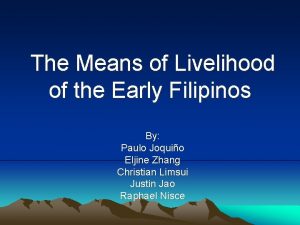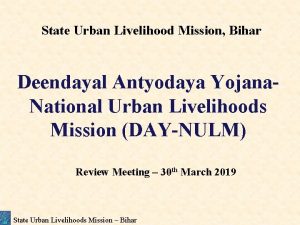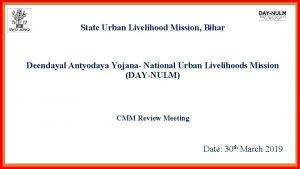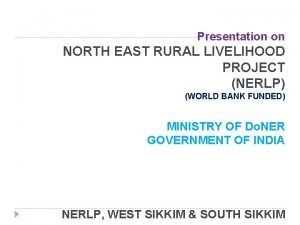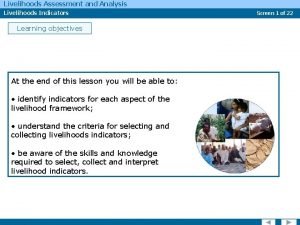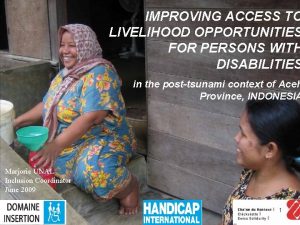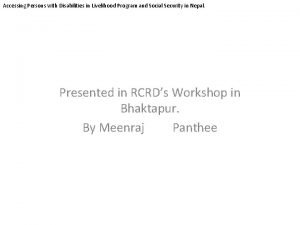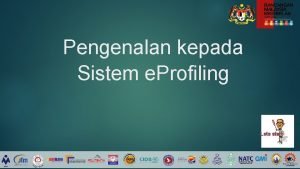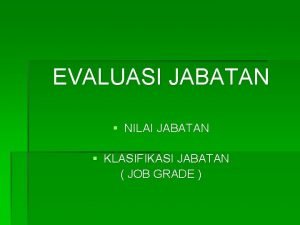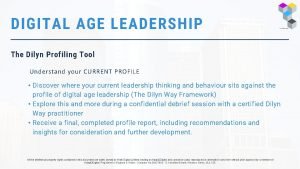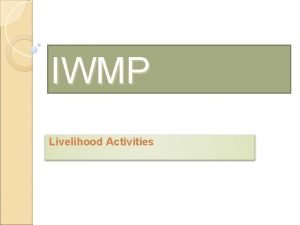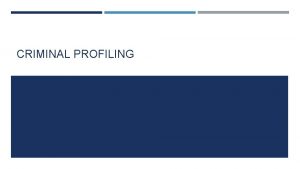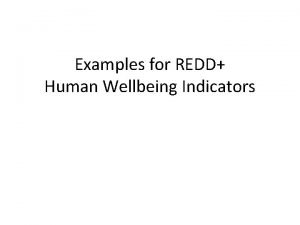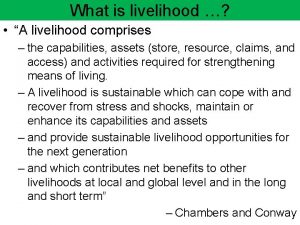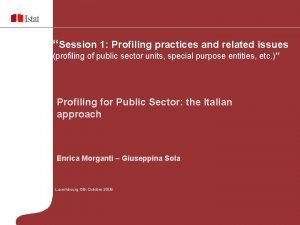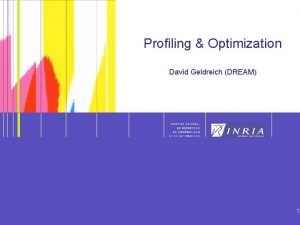Livelihood profiling and sensitivity of livelihood strategies to
















- Slides: 16

Livelihood profiling and sensitivity of livelihood strategies to land cover dynamics and agricultural variability T. Berchoux 1*, C. W. Hutton 2, G. R. Watmough 3, F. A. Johnson 1, P. M. Atkinson 4 *Corresponding author: tristan. berchoux@soton. ac. uk RATIONALE For rural households, whose livelihoods are mainly based on agriculture, a decrease in the area of land cultivated can have significant consequences on their livelihood strategies, thus on their livelihood outcomes. However, it is still unclear how changes in cultivated area and agricultural productivity influence households’ livelihood systems, including community capitals and households’ livelihood strategies. This study investigates how agricultural unpredictability relates to livelihood systems. 1 METHODS CASE STUDY The majority of Odisha’s population depend directly or indirectly on agriculture for their livelihoods (60%), which means they are highly exposed to climate variability. AGRICULTURAL LIVELIHOODS VARIABILITY This study combines together earth observation from space, national census and participatory qualitative data into a community-wise analysis of the relationships between predictability in agricultural production and livelihood capitals. LINKS WITH SDG FRAMEWORK This research uses an adapted version of the Sustainable Livelihood Framework to characterise livelihood systems. 3 2 This approach provides a new lens to inform policies on the role of livelihood capitals for poverty reduction and produces new insights for early warning of crop failures and for sustainable development in rural areas of the Global South. 4 Work carried out within: Click on the boxes if you want to learn more. RESULTS AGRICULTURAL PREDICTABILITY SENSITIVITY ASSOCIATION There is a relationship between the set of livelihood capitals a community has access to and the level of predictability of their agricultural production based on climate indicators. It is argued that climate-crop yield models should integrate frameworks from both climate and social sciences to take into consideration the actions of communities on their environment, which modifies the impact of climate on ecosystems. ABOUT If you want to learn more about the team and about our research project. With financial support from:

RATIONALE Deltaic landforms are formed by a combination of rivers, which make them very exposed to sea-level rise and floods from both rivers and oceans. Their low gradient facilitates the spreading of floods across plains. They also are the draining endpoint of 42% of global terrestrial runoff (Ericson et al. , 2006). Despite the importance of agriculture for livelihoods in developing countries, there is no clear understanding of the impacts of hazards on livelihood systems. There is a need for better understanding of the quantitative impacts of hydro -meteorological hazards on the livelihoods of populations affected (FAO, 2015). ©CRED The projected increase of the average mean temperature is going to modify precipitation patterns. It will lead to a higher frequency and intensity of hydro-meteorological hazards such as floods, cyclones and droughts (IPCC, 2013). Rural people in deltas rely on the environment for ensuring their food security and their economic incomes (MEA, 2005). However, hydro-meteorological hazards lead to crop and livestock losses, thus they have a direct negative impact on food security and households’ livelihoods (FAO, 2015). RATIONALE FRAMEWORK CASE STUDY METHODS RESULTS SDG ABOUT

FRAMEWORK Learn more about the Sustainable Livelihood Framework Click here if you want to know more RATIONALE FRAMEWORK CASE STUDY METHODS RESULTS SDG ABOUT

FRAMEWORK The link between climate stress and loss of agricultural production is complex and involves agricultural practices that cannot be tackled without taking into account the socio-economical context. As an example, having access to some resources such as a drainage canal might mitigate the effects of a flood. Thus, it appears necessary to take into account the mitigating effect of community resources while studying the sensitivity of agriculture to climate variability. There is no consensus on the concept of poverty and that most attempts to build poverty indicators are reductive. On the contrary, livelihood approaches provide an integrated lens by which to understand relationships between human communities and the environment in the broader context of rural development. It also appears that rural households put in place livelihood activities based on their access to livelihood capitals. Characterising such links is a mandatory step towards a better understanding of rural communities needs, thus to adapt rural development strategies in the light of achieving the Sustainable Development Goals. RATIONALE FRAMEWORK CASE STUDY METHODS RESULTS SDG ABOUT

FRAMEWORK Households have access to different assets; this relationship can be modified by the institutions, social networks and organisations at both local and national levels. Assets to which households have access are called livelihood capitals, and are transformed into outcomes (improved food security, increased well-being) by its members through a different panel of livelihood activities. RATIONALE FRAMEWORK CASE STUDY METHODS RESULTS SDG ABOUT

CASE STUDY Click here if you want to know more Map of the case study Timetable of the natural hazards that affected the State of Odisha Evolution of the number of holdings and farm area in the case study RATIONALE FRAMEWORK CASE STUDY METHODS RESULTS SDG ABOUT

CASE STUDY Coastal plains are one of the most vulnerable geographical zones to climate variability and natural hazards. In these regions, the level of poverty is very high, due to the marginalisation of rural people and to the high density of population. Considering the fact that most rural dwellers rely on agriculture for their livelihoods, land pressure leads to the scarcity of arable land in coastal plains thus farmers intensify their farming systems, which leads to the over-exploitation of the environment (Dixon et al. , 2001). On the long-term, such dynamics will lead to a decrease in food production and in water availability, negatively affecting human health and livelihoods, because of the loss of ecosystem services. Also, this increased pressure on the environment will increase exponentially the vulnerability to disasters because of the loss of some ecosystem services (Rosegrant & Cline, 2003). We selected the Mahanadi delta located within the state of Odisha in East India as a case study. Odisha is one of the poorest states in India, with a high prevalence of poverty and a great climate vulnerability with frequent impacts of floods and droughts (World Bank, 2008). This delta is highly populated with a population of 3. 88 million people (Ericson et al. , 2006) and more than 70% of the total workforce is employed by the agricultural sector, thus with their livelihoods relying on the environment (Registrar General and Census Commissioner, 2011). RATIONALE FRAMEWORK CASE STUDY METHODS RESULTS SDG ABOUT

METHODS Click here if you want to know more RATIONALE FRAMEWORK CASE STUDY METHODS RESULTS SDG ABOUT

METHODS The main remote sensing data source is MODIS surface reflectance products. They are estimates of the surface reflectance for each one of the two following bands: band 1 (620 -670 nm) and band 2 (841 -876 nm). The Wide Dynamic Range Vegetation Index developed by Gitelson (2004) preserves a linear relationship with the Leaf Area Index/vegetation fraction (Guindin-Garcia et al. , 2012). Duncan et al. (2015) found that the WDRVI was better than the Enhanced Vegetation Index (EVI) at estimating crop yield over the coastal plains of Odisha. Z-scores are calculated for each pixel and for each year over the growing season. A positive zscore means that there is a greater amount of vegetation in croplands, while a negative z-score means that the agricultural production is lower than usual. RATIONALE FRAMEWORK CASE STUDY METHODS RESULTS SDG ABOUT

METHODS Click here if you want to know more RATIONALE FRAMEWORK CASE STUDY METHODS RESULTS SDG ABOUT

METHODS The Census of India 2011 is the main source of high resolution data on demographic, social and economic indicators widely available in India. Indicators were chosen based on an in-depth participatory fieldwork conducted in 10 communities and on a systematic review of the livelihood literature. A maximum likelihood factor analysis was conducted to reduce the number of dimensions. Each component extracted represents a set of variables. RATIONALE FRAMEWORK CASE STUDY METHODS RESULTS SDG ABOUT

RESULTS Correlation map of the regression between WDRVI standardised anomalies and standardised anomalies of rainfall and temperature have Density plot of R-squared for the regression [WDRVI ~ rainfall + temperature] Unpredictability (low R-squared) is aggregated in clusters and seems associated with the proximity to rivers and to a large forest area. Results been checked upon agricultural shocks (negative breaks in time series representing floods – below) and unpredictability seems related to floodprone areas. RATIONALE FRAMEWORK CASE STUDY METHODS RESULTS SDG ABOUT

RESULTS Click here if you want to know more RATIONALE FRAMEWORK CASE STUDY METHODS RESULTS SDG ABOUT

RESULTS Proximity to rivers leads to a greater unpredictability of agricultural production The greater the area of cultivated land is irrigated, the more predictable its agricultural production is Communities with a high predictability of their agricultural production have seen an increase (or stabilisation) of their proportion of cultivators between 2001 and 2011 Unemployment is correlated with communities with low human capital RATIONALE FRAMEWORK CASE STUDY METHODS RESULTS SDG ABOUT

SDG Unpredictability increases with Unpredictability associated with Proximity to rivers Absence of irrigation systems Increase in unemployment Scientific implications Interdisciplinary frameworks to characterise the impacts of climate change Climate change research to integrate social sciences Weather insurance to control for socioeconomical variables Farm exit - Migration and Employment policies Need to control for unpredictability Use of livelihood framework for creation of assets Farm exit and NRLM Support diversification to reduce vulnerability Income-generating activities through social capital Support to rural services Further irrigation Access to markets RATIONALE FRAMEWORK CASE STUDY METHODS RESULTS SDG ABOUT

ABOUT T. Berchoux Geography and Environment University of Southampton (UK) F. A. Johnson P. M. Atkinson Social Statistics and Demography University of Southampton (UK) Environment Centre Lancaster University (UK) G. R. Watmough Corresponding Author: tristan. berchoux @soton. ac. uk @Tristan. Berchoux Ecoinformatics and Biodiversity Aarhus University (Denmark) C. W. Hutton Geography and Environment Geo. Data Institute (UK) DELTAS, VULNERABILITY AND CLIMATE CHANGE: MIGRATION AND ADAPTATION DECCMA’s aims are to evaluate the effectiveness of adaptation options -including migration- in deltas in Africa and Asia, and to deliver policy support for sustainable, gender-sensitive adaptation. The project analyses the impacts of climate change and processes of migration across contrasting deltas using survey, participatory research and economic methods. Study sites include the Ganges-Brahmaputra-Meghna delta in Bangladesh and India, Mahanadi delta in India and Volta delta in Ghana. www. deccma. com This work was carried out under the Collaborative Adaptation Research Initiative in Africa and Asia (CARIAA), with financial support from the UK Government’s Department for International Development (DFi. D), the International Development Research Centre (IDRC) (Canada) and the UK Economic and Social Research Council [grant number 1501613]. The views expressed in this work are those of the creators and do not necessarily represent those of DFi. D, IDRC and ESRC or its Board of Governors. Data used in this research come from the Census of India provided by the Office of the Registrar General & Census Commissioner of India. RATIONALE FRAMEWORK CASE STUDY METHODS RESULTS SDG ABOUT
 Early filipino livelihood
Early filipino livelihood State urban livelihood mission
State urban livelihood mission Bihar sulm
Bihar sulm North east rural livelihood project
North east rural livelihood project Srlm mis .in
Srlm mis .in Livelihood outcome indicators
Livelihood outcome indicators Livelihood opportunities for persons with disabilities
Livelihood opportunities for persons with disabilities Livelihood programs for persons with disabilities
Livelihood programs for persons with disabilities Warehouse profiling
Warehouse profiling Students limitations
Students limitations Spokesperson profiling
Spokesperson profiling Tujuan profiling
Tujuan profiling Typological profiling
Typological profiling Channel partner profiling
Channel partner profiling Google wide profiling
Google wide profiling Profiling adalah
Profiling adalah Leadership profiling tools
Leadership profiling tools
